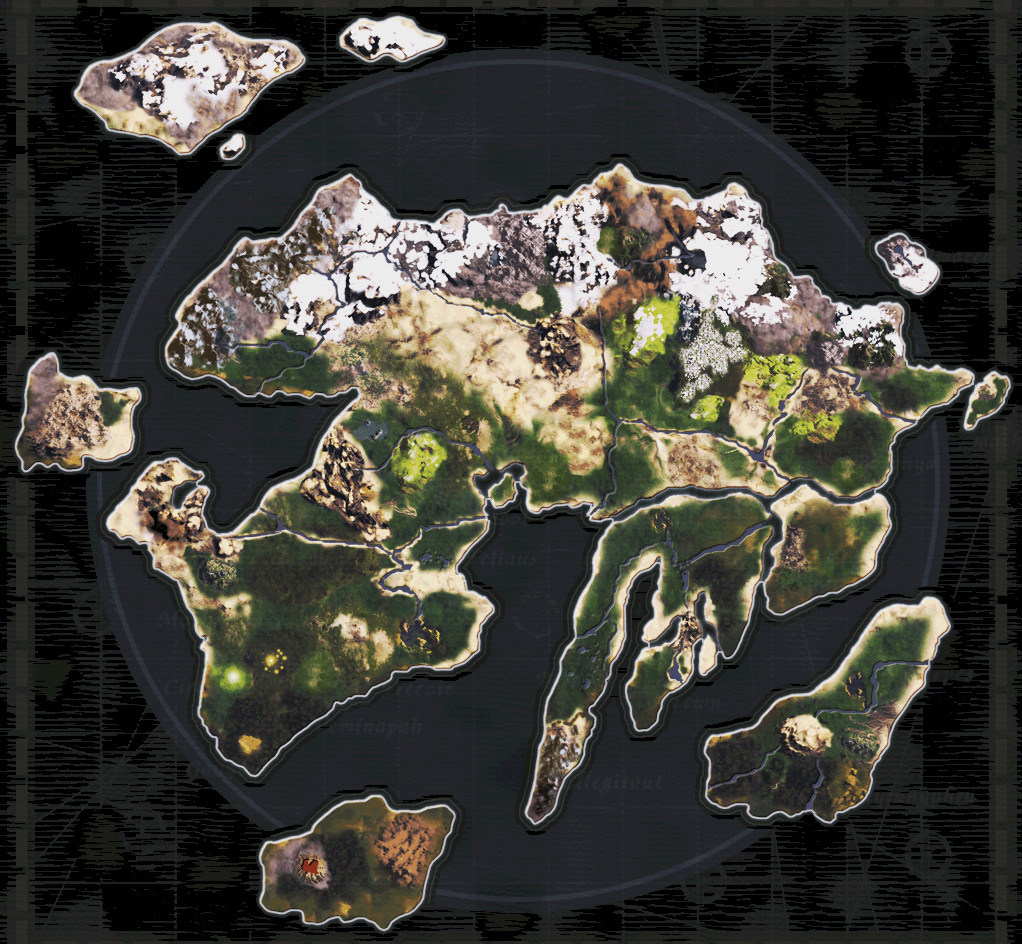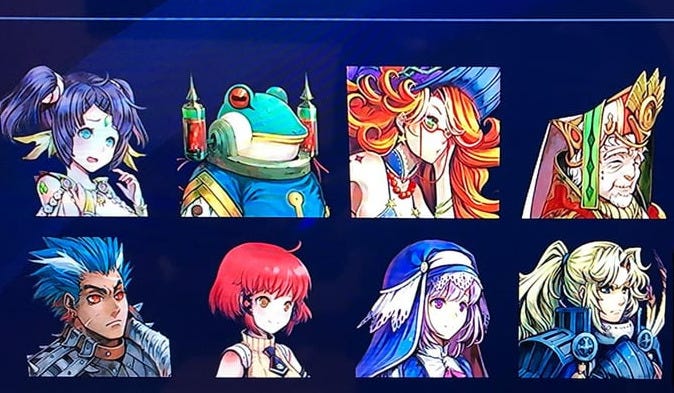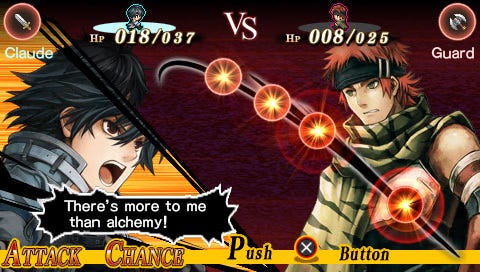Generation of Chaos: Pandora's Reflection, Sting's bumpy tragedy
Developer: Sting (or "Super Sting", to humor their own temporary rebranding), Idea Factory
Publisher: Idea Factory, NIS America
Director: Hidetoshi Ishitoya
Character design: Eiko Tameshige (Dokapon Kingdom, Knights in the Nightmare, Hexyz Force)
Genre: Real time strategy JRPG, largely based on Sting's own Yggdra Unison, an unlocalized NDS spin-off of Yggdra Union
Progression: Linear until the very final stretch, with three endings triggered by a choice made before the penultimate battle and by the way you complete the last one
Release date: 20\2\2013 (European PSN)
Status: Completed on 28\7\2013
Back in the early ‘10s, I felt both Idea Factory’s Generation of Chaos series and tactics-focused team Sting deserved a measure of pity. The former was an interesting grand strategy JRPG franchise (which isn’t that strange, considering Idea Factory was originally formed by ex-Dragon Force staffers), mixing country management with more traditional turn based JRPG segments, whose most accomplished episodes were never localized and whose western reputation is mostly based on the questionable PSP ports of its fourth and fifth entries, which were afflicted respectively by being way too esoteric due to its stratified complexity and way too different from the franchise's own roots, and that isn’t even considering how those games were mostly removed from the Neverland continuity, where the vast majority of Idea Factory’s JRPG output was rooted back then.
Sting, on the other hand, was one of the most imaginative and quirky developers in the tactical JRPG space in the days of GBA, DS and PSP, but never managed to get a major breakthrough in terms of financial success or popularity despite claiming some niche hits like Riviera, Yggdra Union or Knights in the Nightmare. After Atlus USA failed to localize the Yggdra spin-offs and Gungnir didn’t make a splash despite its qualities, likely also due to its localization at the tail end of PSP’s Western lifespan, Sting ended up putting aside its own Dept. Heaven series while turning into a company focused on outsourced tactical combat development for Idea Factory and Aquaplus' titles.
It's no surprise, then, that when Sting, or "Super Sting", as it was rebranded during its partnership with Idea Factory in the early ‘10s, was asked to work on Generation of Chaos’ sixth and last entry, it ended up creating a game that is often depressing, decidedly low budget, a bit self-derivative, and yet ultimately interesting. The somber atmosphere permeating Generation of Chaos 6 also extended to its own development context, since those were the years when Idea Factory was dismantling its old JRPG franchises (Spectral Force, Generation of Chaos and Spectral Souls, to name a few, all rooted in the abovementioned long-running Neverland continuity) to gradually focus its JRPG development resources on Compile Heart's new series, first Cross Edge and Agarest, and then Neptunia.

Thus, Generation of Chaos 6, known in the west as Pandora's Reflection, marked the departure from Idea Factory's Neverland continent, which, unbeknownst to most JRPG fans, is still the non-crossover JRPG shared setting with the largest number of games in the whole genre, surpassing even the likes of Kiseki, Suikoden or Kingdom Hearts on a purely quantitative level and competing with Forgotten Realms' Western RPG spin-offs thanks to more than twentyfive titles set during its long (and admittedly rather confusing) history, starting with Spectral Tower and Spectral Force on PS1 and ending with Blazing Souls on PSP and the ill-fated Spectral Force Genesis on Nintendo DS.
In an attempt to reboot the series, Pandora’s Reflection ended up being set in its own setting, the world known as Hades, with a monster mascot, bug-like Hiyokos, as the main thematic link to the series' old setting.
This world’s name is aptly chosen, since it quickly becomes apparent how this hellish setting could almost be Sting's take on Ravenloft, albeit without the Dark Powers' mysterious influence justifying its ills, considering how grim things can get, to the point of feeling a bit too edgy in its attempt to mix every single instance of dark fantasy narrative the writers could brainstorm.
This wasn't a complete break with Sting's previous works, granted, as the Yggdra games and Knights in the Nightmare were bleak enough, while Gungnir's narrative tried to make its best impression of Yasumi Matsuno's Tactics Ogre while managing to be almost as brutal as Vandal Hearts 2’s story, and yet Pandora's Reflection tried to push this to the extreme, albeit with a more supernatural-oriented plot compared to the war stories featured in most of those games.
Pandora’s Reflection’s story, which back in 2013 immediately reminded me of both Nier and Legasista, has poor alchemist Claude and his sister Yuri, traveling on a quest to find a cure for her mysterious illness. During their travels, they will face in no particular order ashen rains, armed revolutions, ridiculously cruel aristocrats, corrupted clergymen, wars, torture, epidemics both natural and magical, human trafficking and experimentations and other horrors, not to mention quite a number of positively crazy villains, making Hades seem not just an unfortunate place to live in, but somewhat of a misery-themed theme park that would have an hard time surviving as a moderately plausible setting without collapsing into utter chaos in a matter of weeks.
It doesn't help that most of the recruitable cast aren't really characterized in a way that fits with such a desperate world, instead embracing more traditional shounen archetypes, sometimes acting all surprised when the story forces them to actually interact with the world they have always lived in and its many ills. In a way, though, one can’t fault the writers for trying to preserve a modicum of lightheartedness, considering how far they pushed their story in the opposite direction.
Given how its narrative sometimes feels more like a parody of its own tropes, it isn’t that surprising that gameplay ends up being the most interesting thing about Pandora's Reflection, albeit with some caveats: the combat system is, in fact, mostly lifted from one of Sting’s lesser known efforts, Yggdra Unison (not to be confused with the much more famous Union) on Nintendo DS, and ditches Generation of Chaos's grand strategy staples in terms of resource and kingdom management, war planning and army building in order to focus on a simplified Real Time Strategy template somewhat reminiscent of Growlanser, Ogre Battle or Unicorn Overlord, with battle maps sporting long-range artillery positions and bases you can use to respawn your characters and heal your wounded units, and to deny enemies the same grace when you manage to conquer their own.
Units move in real time, often noticeably affected by terrain modifiers and by the day and night cycle in order to make each ally more unique, with a number of equipments making those traits even more pronunced. , and, when they collide with an enemy, they fight using quick time event prompts conceptually similar to Legend of Dragoon's Dragoon Attacks, or to Shadow Hearts and Lost Odyssey's Ring system (not to mention Tsugunai’s defensive options), by pressing a button with the correct timing in order to maximize each unit's damage, a feature recently popularized by the likes of Yakuza: Like a Dragon and Clair Obscur.
Weapons also interact between themselves using a traditional rock-paper-scissor weakness system, akin to Fire Emblem’s weapon triangle, and can be strenghtened in a variety of ways by spending alchemy points, a currency obtained after battles which can also be used to give additional experience points to struggling allies.
Amusingly, damage also influence the knockback distance affecting the enemy unit, which can end up bouncing around the battlefield or against other enemies like a strategy version of billiard or an amusingly dark flipper. While juggling enemy units and conquering bases can definitely be fun, not to mention how Claude can contribute yet another quirk due to his powerful and varied summoning abilities (reminiscent of Gungnir’s Giulio), it doesn't take long for battles to become a bit too samey, even if at least they can provide a modicum of challenge and sometimes end up in a tense tug of war, forcing the player to rush enemy positions just before they manage to capture the heroes' own forts.
Still, even if the game does last a bit too much compared to the variety of contents it can provide, its combat system is at least unique and imaginative enough to support it, showing how Sting was still able to produce entertaining titles even when served with a shoestring budget.

Curiously enough, Pandora's Reflection's most visible legacy has been its characters' PSN avatar portraits, created by Eiko Tameshige, which are surprisingly still used by lots of people who likely never played the game, or even know it exists. Tameshige has a very interesting mixed background that, in a sense, predated the Super Sting partnership, having worked on a number of titles from both Idea Factory and Sting before tackling Generation of Chaos 6’s character design.
Then again, this game is also a rather sad farewell to two series that could have had a better fate, with Generation of Chaos (and grand strategy JRPGs as a whole) being completely abandoned by Idea Factory after almost two decades of experiments started when J-Force was working on the original Dragon Force on Saturn, and Sting’s Dept. Heaven becoming unprofitable enough, aside from some extemporaneous ports, to convince Sting to work almost only as contractors, sometimes recycling older mechanics and design concepts in other companies' titles.
This trend was exemplified by Pandora’s Reflection’s own director, Hidetoshi Ishitoya, which had previously mainly worked on graphics-related development roles, later ending up working exclusively for a decade or so on Aquaplus and Idea Factory-related projects, including 3D modeling and effects for titles such as Tears to Tiara 2, the Utawarerumono franchise, Neptunia’s tactical spinoff Hyperdevotion Noire or Fairy Fencer F. With that said, the recent announce of Dokapon-inspired Viractal seems to signify Sting’s return to independent development efforts, which hopefully could also herald a comeback to the tactical JRPG space later on.







